I’m going to do a little looking back before I charge forward. Here are some thoughts about three shows Libby told you about and which I saw last week: Tina Newberry at Schmidt-Dean; Field Questions at Rosenwald-Wolf and the Lewis and Clark-based exhibit at Moore College. Libby’s posts are here, here and here.
I’ll be brief and re-iterate they’re all worthy shows and up for a while so I encourage you to get out and see them.
Gaze into my eyes
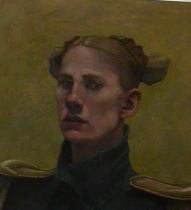
All English majors are specialists in symbol and subtext and my years of digging and delving beneath the surface of texts has transferred over to art which I love to pick apart and analyze for hidden meaning. So when my friend Ann and I saw Tina Newberry‘s autobiographical paintings, which seemed to be all about dress-up and a kind of old-fashioned militarism, I immediately thought of a certain contemporary world leader prone to militarism, dress up and premature declarations of “Mission accomplished.” But no, Chris Schmidt told me, Newberry’s work is not fueled by contemporary politics. The current body of work, all made in 2004, comes out of the artist’s immersion in the world of antique gun-fanciers. Not exactly re-enactors, Schmidt said, the group is comprised of folks who own real muskets and actually go out there and shoot them (like, at targets). (image is detail of Newberry’s “Self-Appointment”)
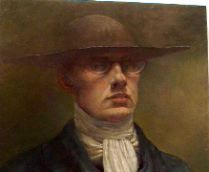
That cleared up, I found Newberry’s world one of fierce gazes and raw self-speculation. There are a number of woman in interior paintings that read as through the looking glass views of the artist in a symbol-laden world. Most reverberant for me were her portrait busts which offer unblinking confrontations between viewer and artist. I loved these works for their ability to raise the mirror and offer that human interaction of looking into someone else’s eyes and thinking about what it means to be you, and how you differ — or don’t — from someone else. Portraits that offer hard gazes are assertive. I’ve always thought they are important in helping to chronicle the age. Newberry’s portraits offer, in addition to direct confrontation, a world of questions about male and female roles, and the role of clothes and costume. And while they’re really not at all about fashion, there is some element of fashion in the artist’s dress up that mirrors our own time’s fascination with the glossy surface of things. Excellent show. (image is detail of “L’il Deacon.”)
The question
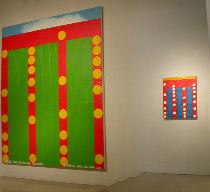
Sid Sachs’ exhibit at Rosenwald-Wolf is a high concept affair. The curator asked a group of abstract painters to field some questions about why their type of art was relevant today. It’s a fair question. The artists emailed their responses to the curator and sent some paintings to display, and voila, the show. There’s a catalog coming soon which will lay the questions out. Until then, the exhibit is enigmatic, with some strong work (Chris Martin) and some less so. Martin’s big and little paintings are a particular type of abstraction — call it Thomas Nozkowskian. They seem based on something real (game boards, computer circuitry, maps, bar charts, “dots” candy strips). And they offer a point of view about the world — about power, life and death. While not really spelling it out, these paintings speak of a need for control and order and what could be more relevant than that thought in a world so clearly without both. Martins’ paintings have a messy, full-speed ahead craftsmanship that makes them seem tossed off and even a little feverish. Sachs told me that on the contrary the works take a long time to make and often are painted on top of other paintings (his own or other painters’ canvasses). In any event, the human hand is a big presence in the works — as is a ruminant mind. Without a written explanation, these works make the case for their relevance today. As for the other works, which seemed bound up in formalist concerns, I’ll wait and read the explanation in the catalog. (image is installation shot of two Martin paintings)
The critique
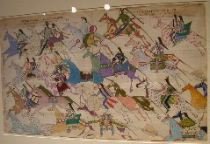
I loved the big Lewis and Clark exhibit at Moore College. (See my review in PW on Wednesday for more.) In particular, I loved Bently Spang‘s videos in the gallery window. The artist (a member of the Northern Cheyenne nation) plays with the stereotypes of Native Americans in works that both mock the stereotypes and hold them in esteem. Thomas Haukaas‘s beaded memorial shirt and his wishful drawing of a tribe moving to a more prosperous future were assertions of Native culture and poignant for their earnest looking back to look forward. (image is Haukaas’ drawing “More Time Expected”)
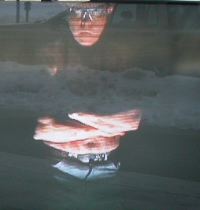
The show, which is an almost-expected critique of western expansion by the white man into pristine and already inhabited territory is nonetheless a great viewing eperience. So Western in its affect, the show is unlike others you’re liable to see in Philadelphia. The only thing even vaguely comparable is “Broken Western” at 222 Gallery back in April, 2004, which brought a group of Western artists together with work commenting on similar issues (ecological, cultural and social). (See post about that show.) (image is from Spang’s video “Bigfoot,” sorry about glare from the window)
Next up, something new.









